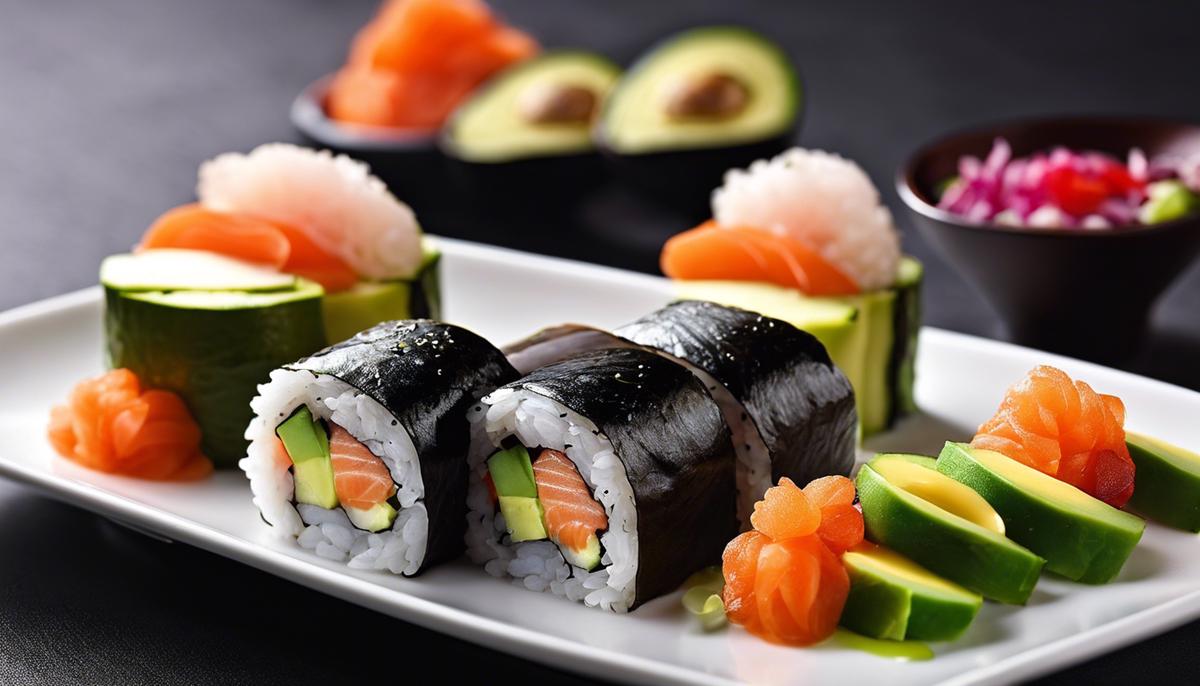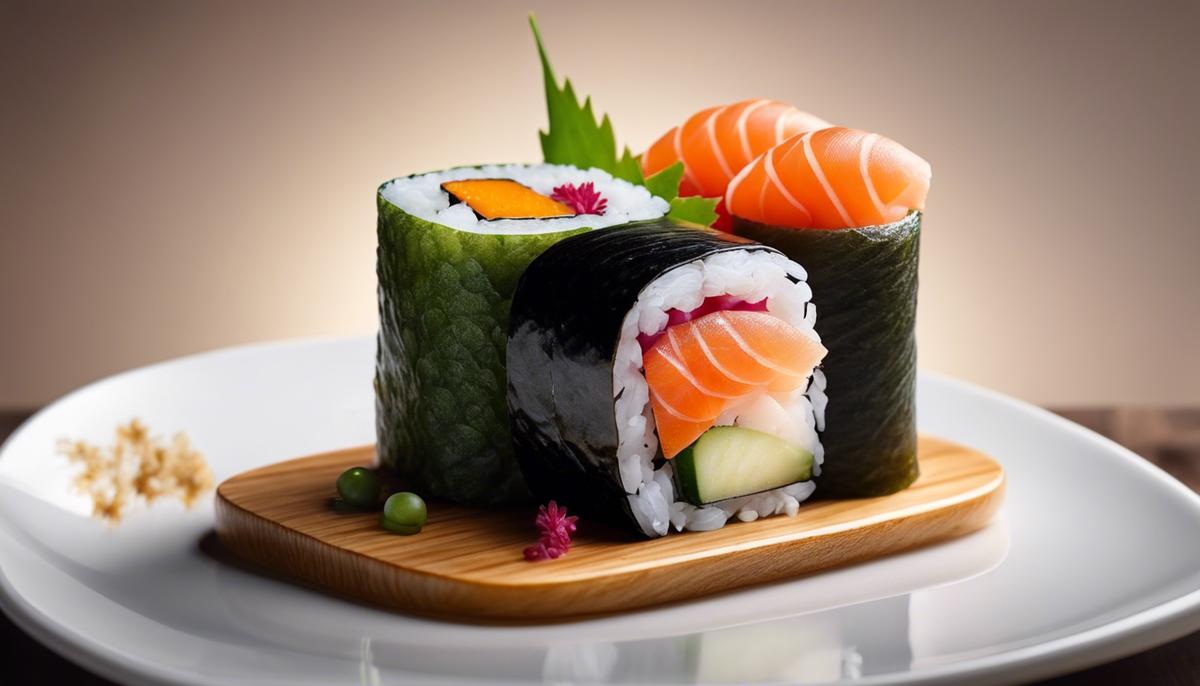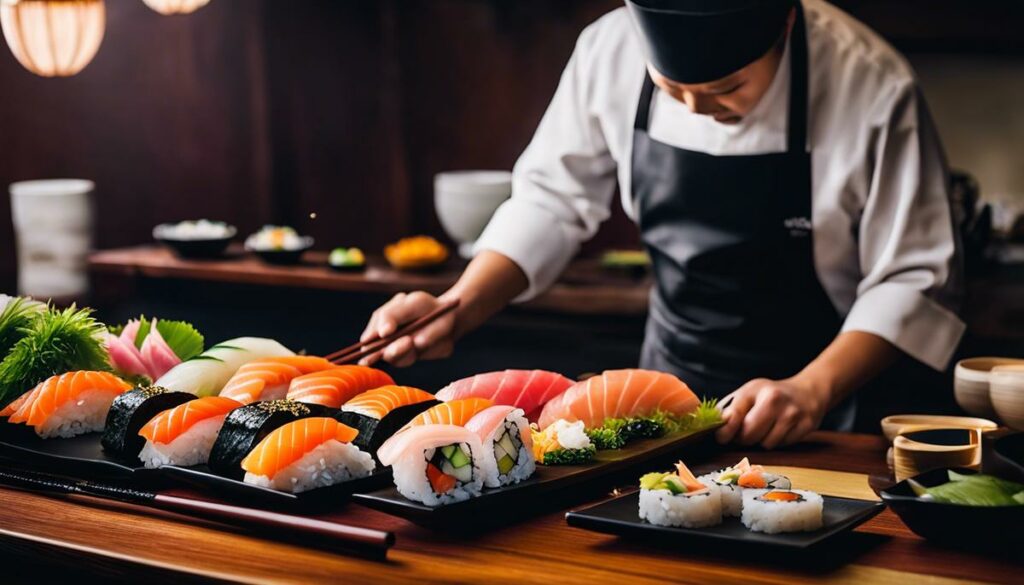The art of sushi making is a fascinating skill that requires both elegance and skill. With this in-depth guide to the secrets of sushi preparation, we open the door to an exquisite world full of taste, tradition and craftsmanship. Whether you’re already a sushi lover or simply curious about this multifaceted aspect of Japanese cuisine, this guide will guide you on your journey. From basic cooking techniques, to the different types of sushi and their unique characteristics, to the deep-rooted history and culture surrounding sushi – all this is explained in full.
Basics of sushi preparation
Rolling sushi is an art. It requires patience, technique, and understanding of the intricacies of each ingredient. But don’t worry, with the right guidance and practice, anyone can master the art of sushi rolling!
The first element to mastering sushi rolls is choosing the right ingredients. Fresh, high-quality ingredients are crucial. Only the best is good enough. Think sliced raw salmon, creamy avocado, and crunchy veggies. And, of course, it is impossible not to forget about the vital element – rice. Sticky sushi rice is the centerpiece of any sushi roll and the right texture and flavor are crucial.
The second component to perfecting the sushi roll is related to the preparation. The preparation of the ingredients can make all the difference in flavor and texture of your sushi roll. It’s not enough to just have the best salmon or tuna. It is also properly cut and prepared.
The right technique is also crucial. It takes practice and precision to create the perfect reel. Every movement should be fluid and goal-oriented. Whether it’s spreading the rice on the seaweed or rolling the mat firmly, the key is mastering the techniques.
After all, the presentation of the finished roll is just as important as the manufacture. Creativity and an eye for aesthetics play a huge role in the sushi world. A touch of wasabi here, a garnish there, and your sushi roll is ready to be enjoyed!
Remember, rolling sushi isn’t just about technique, it’s also about passion and dedication to great cuisine. With practice and dedication, anyone can learn and master the art of sushi rolling. And don’t forget, it’s not a race. Take your time, enjoy the process and most importantly, have fun! Because that’s what sushi making and life is really all about, right?

Different types of sushi
Sushi is not only a culinary masterpiece, it is also a must in any lifestyle conversation. In its simplicity lies its complexity, and it is precisely this fascination that has made sushi a global phenomenon. There are countless types of sushi and each one has its own peculiarities. Let’s take a closer look at some of them.
The classic and probably best-known type is the nigiri sushi. This is a small portion of rice on which a piece of fish or seafood is placed. Sometimes the whole thing is fastened with a strip of nori (seaweed). Here the art is in the balance – the proportions between rice and topping are crucial for the perfect taste experience.
Maki sushi is probably the type most of us know as “sushi.” It consists of rice and various fillings that are rolled in nori and then cut into smaller pieces. There are countless variations of maki, from traditional to creative. The rolling technique requires skill and care to ensure that each roll is uniform.
Chirashi sushi is a more free form of sushi and less formal than the others. It consists of a bowl of sushi rice topped with different ingredients – often different types of fish and vegetables. Here, the focus is on versatility and the playful use of colors and textures.
Temaki sushi, also known as hand rolls, is a cone-shaped roll in which nori is wrapped around the ingredients. This is about an interactive and more personal dining experience.
Finally, there’s oshi sushi, or pressed sushi. Here, the rice is pressed into a special mold and then topped with fish or vegetables. This sushi is often served in blocks that are cut into smaller pieces. Precision and craftsmanship are at the forefront here.
The world of sushi is fascinating and diverse, and it is constantly evolving. Whether you’re a sushi enthusiast or a newbie, there’s always something new to discover and appreciate. It’s more than just a meal, it’s a combination of technique, art and passion. In many ways, sushi embodies the lifestyle we all aspire to – it’s elegant, sophisticated, and infinitely attractive. So, why not embark on this culinary adventure and explore for yourself what kind of sushi is your favorite?

History and culture around sushi
But where does sushi culture come from? The origins of sushi are mysterious and legendary, with its history being traced back to the ancient times of the Nara Age in Japan. Originally, sushi was developed as a method of preserving fish and was a street food that was simple and straightforward to enjoy.
Nowadays, sushi has become a culinary work of art that has found its place at the tables of some of the world’s most exclusive restaurants and lifestyle venues. Sushi isn’t just food; it’s a lifestyle conversation – a form of expression. And yet its true beauty lies in the simplicity and complexity of its preparation. This is where minimalist design meets culinary complexity, and the results are always phenomenal.
Sushi has become a worldwide phenomenon that spans continents and cultures. What once began as a regional specialty is now a fundamental building block of the international gourmet scene.
There is a variety of sushi shapes to discover: nigiri, maki, chirashi, temaki, oshi – all rich in colors, textures and tastes whose variety is hard to beat.
The art and balance of nigiri sushi is remarkable, while the different variations of maki sushi will delight even the most creative palates. Chirashi sushi, on the other hand, offers a colorful mix of flavor and texture with its versatility and playfulness. Temaki sushi offers an interactive and personal experience, whereas oshi sushi demonstrates full craftsmanship and precision.
Welcome to the ever-evolving world of sushi. Here, each piece is a combination of technique, art and passion. Discover the elegance, sophistication and appeal of sushi, and let yourself be encouraged to find the perfect sushi for you. In all their forms, these little bites know how to tell a story in every bite, offering a culinary experience that goes far beyond the ordinary.

Etiquette and presentation of sushi
Well, let’s focus on serving sushi as well as the most important rules of sushi etiquette. It is well known that food and aesthetics are inseparable elements in Japanese culture and sushi, this unparalleled culinary work of art, is certainly no exception.
A crucial part of the sushi experience is its presentation. A stylishly served sushi is a feast for the senses, inviting you on a journey through the intriguing flavors and textures of this Japanese treat. Sushi is usually served on minimalistically designed, usually square or rectangular plates. This classic presentation highlights the natural beauty of the sushi pieces and allows them to shine as true stars.
As far as sushi etiquette is concerned, you should be aware that these rules are not there to inhibit the enjoyment of sushi, but to enrich and intensify it. First of all, sushi is finger food. It is perfectly acceptable and even recommended to eat sushi with your hands. Nigiri, for example, is often eaten with the fingers to maintain the fine balance of the rice and the fish.
Equally important is the soy sauce. Keep in mind that soy sauce is not meant to drown the sushi, but to enhance its natural flavors. Therefore, always dip the sushi fish side first in the soy sauce. The rice must not touch the soy sauce, otherwise it will fall apart easily.
Last but not least, the ginger. Ginger is served in thin slices and serves to cleanse the palate between the different pieces of sushi. Therefore, you should never put ginger directly on top of the sushi.
To sum up, serving in style and adhering to sushi etiquette help enrich the rich dining experience that sushi provides. It’s not just about eating a meal, it’s about celebrating a culture, an art form and, above all, an unparalleled experience of pleasure. Try it out for yourself and who knows, you might even discover your own personal sushi style!

Now that you’ve acquired this arsenal of knowledge and skills, you’re well on your way to joining the ranks of sushi masters. It’s not just about how to roll sushi or how to present it in style – it’s about respecting and appreciating the art and craft in all its depth. By mastering the different techniques and appreciating the uniqueness of each type of sushi, you will be able to create not only tasty, but also convincingly presented sushi. May you overcome the challenges and keep the joy of making sushi until the end of your days.


